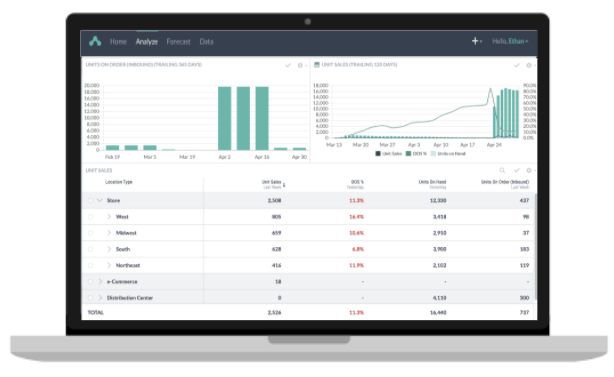Talking better product launch and allocation decisions with Ferrero USA
The global confectioner mitigates waste, improves service levels and controls costs by connecting digital supply chain visibility with POS analytics.
Keep readingFounded in the 1980s, this sporting goods manufacturer is a publicly traded company with some of the most industry-recognized brand names. Their premium products are sold worldwide through direct-to-consumer and online and offline retail channels, including Amazon, Walmart and Dick’s Sporting Goods.
This Retail Sales team was no stranger to point-of-sale data; with strong CPG backgrounds, they knew the power of decisions based on true demand. However, this key information was not so readily available in their new industry, though their long lead times made it even more critical to react to sell-through instead of sell-in.
The company received retail data from a variety of sources, including many retailer portals and an EDI provider. An analyst had to spend hours every week manually collecting the data from each one and standardizing it to create just basic customer sell-through reports. When ad hoc reports were needed, even more time had to be spent gathering the right data and putting it together in a meaningful way.
This cumbersome process meant the Sales Directors couldn’t get the insights they needed. While their buyers were looking at SKU-level performance and asking for actionable information to take back to Operations, they were limited in how they could look at the data. Inventory data was hardly ever taken into account.
Especially as the company’s assortment grew, this lack of detail made it difficult to pinpoint which products were doing well and grow their sales. Major meetings, like annual line reviews, required them to give the analyst at least a month’s notice to put together the business summary, which often consisted of 15+ different cuts of their rigid data sets. The team struggled to build the story about how their brands performed and secure retail placement.
When the team saw Alloy for the first time, they were blown away by its flexibility. Not only could it combine all their different retail data sources and produce their weekly sales reports, but they could easily drill up or down and filter the data—something they had not seen from others. It enables them to analyze SKU-level performance, so when products in the same category are trending in opposite directions, they can easily spot it and dig deeper. They are also on the same page as their buyer, and build confidence in their recommendations by showing how they’re backed by data.
"Alloy is a very dynamic system and accessible to everyone. We had POS data before, but were limited in what we did with it. With Alloy, I don’t think there’s ever been a case where we’ve come up with a scenario of what we’d like to see and been told we can’t do that.”
Alloy software further stood out because of how turnkey and accessible to everyone it is. Any Sales rep can access the data and get a comprehensive picture of their account, as well as other accounts. They can now do analysis on their own, without having to further burden the analyst for simple requests.
For example, when they notice an unusual trend, they can instantly ask the next question and understand whether it’s an anomaly or not but comparing the item’s performance at other accounts or across accounts. If they’re scrambling to put together a presentation, or even sitting in a meeting, that immediate answer can be the difference between making a sale or having the conversation drag out over days.
On at least a weekly basis, each rep uses Alloy to check sell-through in the past four weeks and year-to-date, as well as YoY sales, in-stock levels, and weeks of inventory on hand for each product. They closely track changes in trends, whether up or down, so they can affect change in their supply chain before it’s too late and the season ends.
Particularly for new product introductions, Alloy is critical for tracking weekly sales and how it compares to forecast. If inventory gets low, the Sales Directors will review each account’s inventory levels and prices together and use the data to help decide which partners to offer more product too.
The Retail Sales team are the primary users of Alloy, but thanks to Alloy’s accessibility, more teams have also started to use it and it has fueled cross-company collaboration.
Last, but not least, everyone values the service they receive from Alloy’s Client Solutions. Beyond the initial implementation, they never hesitate to help the team find and show the insights they’re looking for and share best practices to maximize the value of Alloy.
“We rolled out a new item to Dick’s Sporting Goods (DSG) this past Fall. With Alloy, I was able to see what their on-hands were at a total level and compare that to previous years, all the way down to the store level. I could quickly identify the stores that didn’t have the item.
I then made an effort to go out and visit about 20 stores, and I verified the data in Alloy identifying stores that didn’t have the product. I also cross-referenced it with data from our store visit partner, and again, the reports matched.
It was actionable information that I could take back to DSG and tell them 1) you’ve ordered too light on this item, and 2) operationally, you don’t have it in all the stores. If they asked why sales on this item are down, I could point to the fact that it’s because they don’t have it in all the stores.
As a result, DSG listened to me and placed additional POs for the item. Over the course of the season we rolled out multiple products, and I think the actionable information we consistently provided will help us going forward too.”
Time savings. The analyst does not need to spend any time preparing weekly sales reports, and when any ad hoc analysis is required, it takes minutes instead of hours. The Retail Sales Directors also have immediate, consistent access to data 24/7 and can do a lot of analysis on their own, freeing them from waiting for the analyst to free up.
Fewer lost sales. The Sales team alerts retail buyers to low or no inventory situations, so they can order more and work with their Operations teams to ensure the product gets on shelf, where consumers can buy it.
For online sales, they balance available inventory between partners who fulfill from their own Distributor Centers (DCs) and ones they support via drop ship. When deciding whether to fill orders, they take into account that if their own warehouse becomes out-of-stock, an item will fall off of partners’ websites. Alloy has enabled them to avoid these situations, where consumers would have no chance of buying their product and the brand would lose exposure.
Less excess stock. Instead of waiting for orders to stop before making a change in their supply chain, the team catches and responds to downward demand trends earlier. They minimize unproductive inventory that ties up capital and warehouse space and hold back investment in items that are selling well.
The global confectioner mitigates waste, improves service levels and controls costs by connecting digital supply chain visibility with POS analytics.
Keep readingDuring COVID-19, Alloy customers are using real-time supply chain visibility and retail analytics to manage day-to-day and track channel & product shifts.
Keep readingLeading-edge supply chain management solution to unlock new insights and opportunities and strengthen retail relationships.
View

